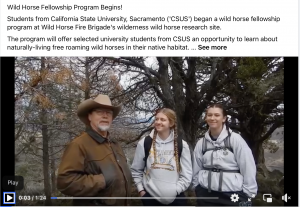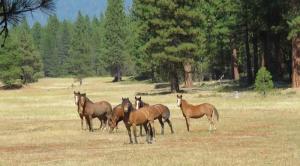
University Students Have Amazing First Day Field Experience At Wild Horse Fellowship Program

Wild horse researcher William E. Simpson II conducting a forensic examination of the remains of a 6-mo. old, 250-300-lb. wild horse. Trauma to the nose area of the skull suggests an attack by a mountain lion

Image from University of Oregon book on Oregon's Petroglyphs shows numerous examples of ancient indigenous representations of wild horses in Oregon
Wild Horse Fire Brigade started its wild horse Fellowship program with students from California State University, Sacramento
Yet wild horses are one of the most understudied large mammals in North America today. And this lack of understanding is resulting in what is arguably the current mismanagement of American wild horses by government agencies.
Wild Horse Fire Brigade, an all-volunteer 501-c-3 nonprofit public benefit corporation, believes education is the key to improving the management of wild horses.
In the interest of helping to provide for the humane, sustainable, natural conservation for American wild horses, Wild Horse Fire Brigade has executed a 5-year contract to provide a wild horse Fellowship program with California State University, Sacramento.
Wild Horse Fire Brigade, along with researchers Michelle Gough and William E. Simpson II own and manage a herd of heritage wild horses. And because these horses are privately-owned, they are jurisdictionally considered 'livestock', and are protected under California law.
For the past decade, William Simpson has lived-among and studied these free-roaming wild horses, full-time, and has gathered a tremendous amount of information about their behavioral ecology and ethology, logging over 30,000 hours of close observational study. Uniquely, Simpson observed and photographed their behavior during a catastrophic wildfire, and how their wildfire grazing helped CALFIRE suppress the catastrophic 38,000-acre Klamathon Fire in 2018. Simpson accomplished this while serving as the volunteer local knowledge advisor to CALFIRE on the fire-line for 9-days.
More here: 'Wild Horses Co-Evolved With Wildfire': https://www.siskiyou.news/2023/12/01/wild-horses-coevolved-with-wildfire-on-the-north-american-landscape
The fact that so much is known about domestic horses has created the general perception that wild horses are the same. But that perception is not accurate. The scientific evidence that has been piling-up over the past decades demonstrates that many popular beliefs about wild horses are simply not true.
Some Common Myths About American Wild Horses:
Myth #1: 'American wild horses have no natural predators.'
Truth: In reality, wolves, mountain lions, bears and coyotes all prey upon wild horses.
Examples:
a. Wolves prey upon wild horses: https://www.zoocheck.com/new-research-paper-shows-wolf-predation-on-wild-horses/
b. Bears prey upon wild horses: https://www.outdoorlife.com/conservation/grizzly-bear-chases-feral-horses/
Myth #2: 'Wild horses in America are an introduced invasive or exotic species.'
Truth: Irrefutable paleontological evidence (fossils and ancient indigenous pictographs and petroglyphs - See Image) provide evidence that all wild horses in the world originally evolved in North America. And that the modern horse we see today (E. Caballus) survived on the North American continent for the past 2-million years. Furthermore, recent evidence (paleontology and cultural archaeology) suggests that splinter populations of wild horses survived the Ice Age in North America, and were present when Columbus first discovered North America in 1492. Subsequent re-introductions of domesticated horses then occurred over the next centuries.
Examples:
a. Dr. Ross McPhee: "Horses are not an invasive species" https://cowboystatedaily.com/2022/09/13/letter-to-the-editor-rod-miller-is-wrong-horses-are-not-an-invasive-species/
b. Lets Talk Invasive Species - Pagosa Daily Post: https://pagosadailypost.com/2023/06/12/opinion-lets-talk-invasive-species/
Myth #3: 'Wild horses damage the landscape.'
Truth: Natural history of the North American continent argues strongly against Myth #3. From the perspective of common-sense, natural history and behavioral ecology, if wild horses damaged the landscape, given the 2-million-years of free-ranging of the modern horse (E. Caballus) in numbers estimated in the tens of millions of horses, the North American landscape should have been made into a dust bowl. However, that never happened as the result of wild horses grazing. However it did happen when invasive species cattle and sheep began grazing in North America upon their introduction.
Examples:
a. The Encyclopedia of the Great Plains states as follows:
"TAYLOR GRAZING ACT (http://plainshumanities.unl.edu/encyclopedia/doc/egp.ag.071)
Public agency management of the federal grazing lands began with the passage of the Taylor Grazing Act on June 28, 1934, as dust from the worst storms in the nation's history settled on Washington DC. Enacted after decades of rangeland deterioration, conflicts between cattle ranchers and migratory sheepherders, jurisdictional disputes, and states' rights debates, the act and its amendments ended free access to the range. The purposes of the act were to stop injury to the public lands; provide for their orderly use, improvement, and development; and stabilize the livestock industry dependent on the public range. The new law effectively closed the rangelands to homesteading in the Dakotas and western states."
b. Professor Thomas L. Fleischner, Ph.D: “The most severe vegetation changes of the last 5400 years occurred during the past 200 years. The nature and timing of these changes suggest that they were primarily caused by 19th-century open-land sheep and cattle ranching.” https://www.academia.edu/11886843/Fleischner_Land_Held_Hostage_A_History_of_Livestock_and_Politics
Myth #4: 'Wild horses serve no purpose and have no value.'
Truth: Wild horses are the only 'non-ruminant' large-bodied mammal in North America. This important fact is related to the differences in the digestive systems of ruminant mammals (cattle, sheep, goats, deer, etc.), which digest the seeds of most native plants and grasses (flora), and the non-ruminant horse that effectively reseeds the landscapes it grazes. Unlike ruminant grazers, horses complete the life-cycles of the plants and grasses they eat because they don't effectively digest the seeds they eat. Instead most of the seeds that horses consumer come-out in their dung, intact and will germinate. Additionally, the seeds in horse dung have a survival advantage over wind-blown seeds due to the seeds being encapsulated and protected in dung that is rich in nutrients and microbiome.
There is also some scientists who believe that wild horses can help slow the spread of Chronic Wasting Disease ('CWD') or Zombie Disease in deer and other mammals. Interestingly, horses are resistant to CWD according to Dr. Mark Zabel of the Prion Research Center in Ft. Collins, CO.
Additionally, wild horses are effective managers of wildfire fuels of grass and brush, the key fuels in all catastrophic wildfires, according to new research cited by By Nadja Popovich in a Nov. 9, 2023 New York Times article: (https://www.nytimes.com/2023/11/09/climate/forest-fires-grasslands.html)
"Forest fires may get more attention, but a new study reveals that grassland fires are more widespread and destructive across the United States. Almost every year since 1990, the study found, grass and shrub fires burned more land than forest fires did, and they destroyed more homes, too."
Examples:
a. Chronic Wasting Disease in Yellowstone And Spreading: https://www.siskiyou.news/2023/11/19/chronic-wasting-disease-in-yellowstone-and-spreading/
b. Wild Horses May Hold a Solution to Slowing Spread of Fatal Chronic Wasting Disease in Deer, Elk: https://www.environews.tv/022718-wild-horses-may-hold-solution-slowing-spread-fatal-chronic-wasting-disease-deer-elk/
c. Wild Horses & Chronic Wasting Disease in Deer: https://pagosadailypost.com/2021/01/18/opinion-wild-horses-chronic-wasting-disease-in-deer/
d. The Dollars and Cents of American Wild Horses: https://pagosadailypost.com/2021/02/05/opinion-the-dollars-and-cents-of-americas-wild-horses
As the few (of many) examples show, the foregoing Myths are disproved in the light of common-sense and accredited, independent peer-reviewed published science cited in the articles that has piled-up over the past two decades.
Nevertheless, the reasons for the ongoing propagation of the Myths about wild horses stems largely from the economic pressures and subsequent conflicts that have grown between the needs of American wild horses, which are wildlife, and commercial enterprises (livestock and extraction industries of gas, oil and minerals) on public lands. Over the past 50-years, increasing commercial-use demands on public lands that are managed by the Bureau of Land Management ('BLM'), have resulted in growing conflicts, which can be remedied with a new Plan that provides better management of wild horses. Education holds the key to implementing a new nature-based solution for wild horse management called Wild Horse Fire Brigade, which benefits all stakeholders and provides humane, cost-effective, and sustainable conservation for America's relatively few remaining wild horses. As history and science record, there were over 2-million wild horses in America in the early 1900's.
Wild horse researcher, William E. Simpson II, believes that as a result of the aggregate of questionable management methods, wild horses may very soon be facing an irreversible genetic bottleneck.
Methods used by the BLM include:
1) Aggressive roundups resulting in remaining herd sizes of free-roaming wild horses that are well below the published minimal herd size of '500 horses' to maintain genetic diversity, as cited by scientists at the International Union for Conservation of Nature, as cited in a published paper: "we recommend a minimum population size (N) of 500 individuals, a studbook, and careful genetic management." https://portals.iucn.org/library/sites/library/files/documents/1992-043.pdf
2) The use of chemical sterilants (PZP and GonaCon) on many of the remaining free-roaming wild horses. The use of chemical sterilants, also known as 'Fertility Control' exacerbates the genetic erosion caused by substandard herd numbers.
According to William E. Simpson II, "as of the end of 2023, there are likely less than 50,000 genetically intact free-roaming wild horses left in America, presenting a serious threat to their ongoing genetic sustainability."
History shows that the Bureau of Land Management, the agency charged with managing wild horses, has some inherent conflict of interest given it has its foundation build upon livestock grazing interests as opposed to managing non-commercial wildlife (wild horses). That fact is well documented at the Encyclopedia of the Great Plains, published by the University of Nebraska at Lincoln. The publication cites the origins of the Bureau of Land Management (aka: 'BLM') as the consolidation of The Grazing Service and General Land Office in 1946 to form the Bureau of Land Management, which continues today to administer grazing lands not in the national forests. (http://plainshumanities.unl.edu/encyclopedia/doc/egp.ag.071)
For the past decade, researchers who are part of the California 501-c-3 nonprofit 'Wild Horse Fire Brigade' have been investigating the behavioral ecology and ethology of a heritage herd of free-roaming wild horses on the border of Oregon and California using what they have coined as the 'Goodall Method' for close observational study of wildlife.
More about the Goodall Method here: https://www.wildhorsefirebrigade.org/post/wild-horses-benefiting-from-dr-jane-goodall-s-leadership-and-work
Now, under the oversight and direction of Wild Horse Fire Brigade's advisory board member, Professor Wayne Linklater, Ph.D. - Chair, Department of Environmental Studies at California State University, Sacramento ('CSUS'), wild horse researchers Michelle Gough and William E. Simpson II will provide on-site guidance to students as teaching assistants for Wild Horse Fire Brigade's novel wild horse Fellowship program. Under this program, students will be able to conduct field studies of free-roaming wild horses in a wilderness area learning about wild horses using the Goodall Method.
More about Professor Wayne Linklater and CSUS here: https://scholars.csus.edu/esploro/profile/wayne_linklater/overview
More about Wild Horse Fire Brigade: https://www.wildhorsefirebrigade.org/about
Deb Ferns
Wild Horse Fire Brigade
+1 858-212-5762
email us here
Visit us on social media:
Facebook
Twitter
Instagram
YouTube
Other
Interview with CAL-State University Students
Distribution channels: Agriculture, Farming & Forestry Industry, Culture, Society & Lifestyle, Education, Natural Disasters, Science
Legal Disclaimer:
EIN Presswire provides this news content "as is" without warranty of any kind. We do not accept any responsibility or liability for the accuracy, content, images, videos, licenses, completeness, legality, or reliability of the information contained in this article. If you have any complaints or copyright issues related to this article, kindly contact the author above.
Submit your press release


